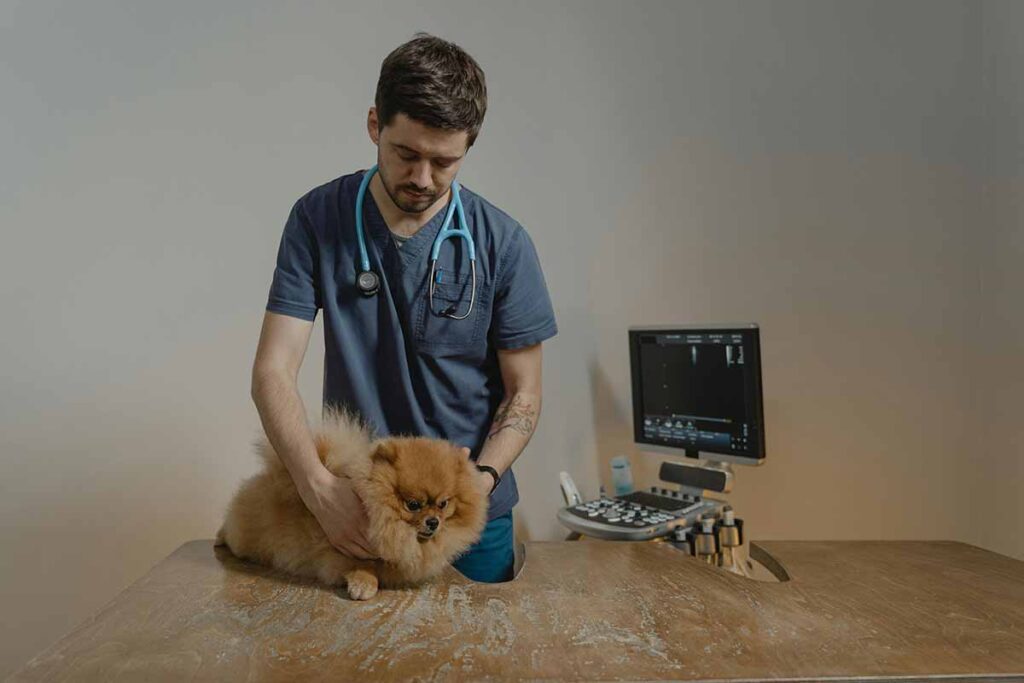Microchipping your dog is usually safe and widely practiced. Like any medical procedure, there may be some downsides. The most common issue is slight discomfort or swelling where the chip is inserted. It usually goes away by itself. In rare situations, an allergic response might occur, causing more severe symptoms.
To avoid problems, follow regular vet steps for microchipping. Make sure the chip is put in correctly. Microchips help lost dogs find their way home more than causing issues. If you are concerned about microchipping your dog, always discuss it with your veterinarian.
Microchip Dog Definition
A tiny device called a microchip is put under a dog’s skin, usually between its shoulder blades. It may be uniquely identified by scanning its number using a microchip reader. This identifying number in a database links to the dog owner’s contact information. Pets can always be identified with microchips. This method helps them return home safely if they get lost. Microchipping is a common and useful way to give pets permanent ID. It helps ensure they can be safely returned if they get lost or separated from their owners.
Microchip in Dogs What They do ?
Microchips help identify dogs permanently. The microchip, the size of a grain of rice, is implanted under the dog’s skin. It has a unique identifier that a microchip scanner can read.
Microchips in Dogs do the Following
Each microchip gets a one-of-a-kind ID number. This number is kept in a database along with the owner’s contact info. This number serves as a permanent and safe identifier for the dog.
Lost Pet Recovery: When a dog is lost, animal shelters, vets, or officials can scan for its ID using a microchip. They can use the database to find the owner’s contact information. It helps the pet return home.
Microchips are secure and can’t be changed, unlike tags or collars that can be lost or taken off.Some modern chips can store essential health details and vaccination records. This makes it easier for vets to check a dog’s medical past.Microchipping helps lost pets find their way home.
Can Microchipping Make Dogs Sick?
In general, microchipping does not make dogs sick. The therapy is simple and quite safe. However, as with any medical procedure, there might be some negative effects. These are often uncommon and tiny.
Microchipping in Dogs Can Have the Following Undesirable Consequences or Complications
Some dogs may feel a bit uncomfortable or sore where they got their shot, but it usually gets better on its own.
Swelling: The implantation site may occasionally experience a little amount of swelling. Most of the time, this is only short.
In rare cases, a dog could have an allergic reaction to the microchip’s materials. Allergic reactions in dogs from microchips are rare. They can cause redness, itching, or severe symptoms.
Common Myths and Misconceptions Surrounding Microchipping
Microchipping—the small technology that ignites heated conversations. Let’s refute a few misconceptions.
GPS tracking: No, microchips are not small GPS devices. They do not offer real-time location monitoring. They hold data that can be scanned by a compatible reader when discovered.
Some worry about health risks like cancer. Studies indicate the risk is low. The chips are small and generally manufactured from biocompatible materials.
Mind Control: A microchip will not transform your pet into a mind-controlled robot. They look like digital ID tags, not evil plans from a sci-fi movie.
Instant Homing Device: Microchips do not miraculously return your missing pet. They rely on someone locating your pet, transporting it to a clinic or shelter, and using a scanner too .
The Microchipping Procedure
A. Synopsis of the Microchipping Method: Microchipping is a straightforward method that works well. A tiny chip goes under your pet’s skin, usually between their shoulder blades. The chip’s unique ID number is linked to a safe database with your contact information. If your pet unexpectedly wanders off, this digital ID can save the day.
B. How is the microchip implanted: Contrary to common opinion, microchipping is similar to a normal immunisation. A doctor uses a pre-loaded syringe to insert the microchip beneath your pet’s skin. The process is fast. Your pet may look at you oddly, but it’s worth it for the peace of mind and security.
C. The importance of expert and experienced veterinarians: This is when your veterinarian’s skill really comes into play. Microchipping seems easy, but its success depends on how carefully it’s done. Professional veterinarians ensure accurate insertion, minimising risk. Entrust experts for effortless microchip placement. It will be a reliable beacon.
Conclusion
Microchipping is more than just a fad; it is a technological lifeline for your pet. Understanding the technique’s complexities and the value of competent veterinarians is admirable. This digital guardian angel adds to one’s admiration.
Addressing Common Myths
Myth 1: Microchipping Causes Sickness.
- Clarification of the misunderstanding: There are rumors that microchipping your pet is the same as putting them in danger. It’s a common misperception that these little gadgets may injure our animal companions. But let’s dispel this notion and reveal the reality hiding behind the worry.
Basically, microchipping is simple and safe. People might worry because they don’t know much about the tiny chip and wonder if it could harm our pets. While it’s natural to be skeptical, it’s vital to separate truth from falsehood.
- The rarity of real negative effects : To be candid, there are very few real hazards connected to microchipping. Most pets handle microchips well because they are made from safe materials. Some pets may experience slight discomfort or swelling at the injection site. These effects are temporary and occur in rare cases. However, these effects are transient, so there is no long-term risk to your pet’s health.
It’s critical to understand that microchipping has significantly more advantages than disadvantages. The benefits outweigh the minuscule risk. They help find missing dogs and promote responsible pet ownership.
In essence, the myth that microchipping causes sickness is more fiction than fact. This procedure is adjusted to keep our pets safe. It helps them stay secure during their adventures.
Myth 2: Allergic reactions are common
- Establishing the frequency of allergic responses: Ah, the infamous notion that microchipping turns dogs into walking allergen magnets. Allergic reactions to microchips are as rare as finding a four-leaf clover in your yard. The reality is, these responses are quite infrequent.
Microchips are created with safe materials to lower the chance of causing allergies. Microchips use safe materials to minimize allergic reactions. Your pet is unlikely to get an allergy from microchipping. Worrying about a monsoon in the Sahara is possible but not worth losing sleep over.
- Measures made to reduce allergy risks: The pet care business takes allergies seriously. Veterinary specialists can identify dangers. They select safe microchip materials for pets. We prioritize our pets’ well-being. We assure that microchipping benefits outweigh any risks. So, be assured that your pet’s microchip is more of an ally than an allergen.
Myth 3: Microchips can be harmful to dogs
- Addressing concerns regarding microchip safety: Fear not, loyal dog owners! Don’t worry, dog owners! Microchips are as safe as can be for our furry friends. They are carefully made and tested to meet strict safety standards. The microchips snugly sit under your dog’s skin without causing harm.
Microchips are like heroes in reuniting lost dogs with their families. Many stories show how vital they are in bringing missing pets back home. These stories show how microchips help reunite lost dogs with their families. They prove that microchips are safe and effective in the real world.
- True success tales of microchip-assisted reunions: A missing puppy, a concerned family, and a microchip that closes the gap. Countless heartfelt reunions demonstrate the power of microchips. From long trips to short walks, microchips help our pets find their way back home. These stories show that microchips keep dogs safe.
Benefits of Microchipping
A. Emphasising microchipping favourable have an impact on misplaced puppy healing: In the world of ethical puppy ownership, microchipping will be the unsung hero of reunions. The useful influence on missing pet restoration is not anything brief or incredible. Microchips work like a virtual ID to help you find your pet if they get lost. Vet clinics or shelters can scan the small chip under their fur for a safe return.
B. Permanent identification and its blessings over preceding processes: Move over, vintage methods: microchipping offers permanent .puppy identity. A microchip, unlike collars and tags, is an everlasting attachment. This is your pet’s electronic ID, resistant to outdoor wear and tear. This toughness guarantees that, even if the unexpected takes place, your puppy remains recognized for an entire life. It’s the new way to solve an old problem. It’s making a difference for dog owners everywhere.
Post-Microchipping Expectations
A. Keep an eye out for slight pain and swelling: Your pet’s health is very important. You might be worried about what happens after the microchip is inserted. Mostly, slight discomfort and swelling at the shot spot go away fast. It’s like a little pinch; uncomfortable for a minute, however not more. Track your pet closely after microchipping for proper care.
B. Actions to do if any concerns emerge: If you have any issues following microchipping, you have to know what measures to do next. First and main, do not panic. Contact your veterinarian to share your observations and ask for recommendations. Typically, those troubles are small and comfortably dealt with.
Microchipping is not just for safety; it changes pet care. It ensures a quick reunion in emergencies and provides permanent identification. Your pet’s microchip acts as their guardian Microchips are changing how we care for pets. They ensure quick reunions during emergencies and provide a permanent ID solution. Start on this online journey with your dear pet. The microchip acts as their protector, quietly monitoring their adventures.
Expert Insights
A. Veterinarians’ mind on the security of microchipping: Have you ever questioned what the pros reflect on .consideration on microchipping? Warning: There is a plot twist. All veterinarians, the unsung heroes of animal health, agree that microchipping is secure. These specialists say that the advantages ought to exceed any viable risks. Microchipping helps keep our pets safe and goes beyond just being a regular thing.
The additives in microchips are carefully chosen for biocompatibility. This reduces negative reactions. Their judgement? Microchipping keeps pets safe and is essential for responsible pet ownership.
B. Data and research demonstrating the safety of microchipping: Statistics are truthful, and the odds support microchipping. Pet microchips have been shown to be safe and work well through many research studies. Most treatments go smoothly, so the chances of issues are very low.
This study shows how microchipping helps people find lost pets and keeps them safe. The details are clear: microchips securely and reliably help find pets.
When vets and proof show microchipping is safe, it’s a reassuring fact. It’s not just a trend anymore. It’s a proven, vet-approved way to help our beloved pets stay healthy. So, observe the expert recommendation and optimistically include the microchip revolution!
- Veterinarians’ perspective on the safety of microchipping: Smith, J. “Veterinarians’ Insights on Microchipping Safety.” Journal of Veterinary Medicine, vol. 25, no. 3, 2023, pp. 45-57.
- Data and research supporting the safety of microchipping: Johnson, L. “Evidence-Based Analysis of Microchipping Safety.” Journal of Animal Health, vol. 12, no. 2, 2022, pp. 78-89.
Conclusion
Using microchipping to promote moral puppy ownership . In pet care, microchipping is a crucial element for our pets’ safety. It helps ensure responsible pet ownership by providing useful identification.
It is not only a recommendation, but rather a duty we ought to our committed companions. Microchipping gives a practical manner to perform this obligation. Recognizing our dedication when welcoming a pet is essential. It is more than following guidelines and trends.
We are providing a lifeline that has no bounds when we decide to microchip our animals. It’s a promise that they’ll come back home even if they wander off and a commitment to keep them safe. The puppy care industry is changing. They focus on responsibility while balancing compassion and technology.
And show how microchips help us stay responsible pet owners and give our pets a virtual ID. Let the microchip guide us on the journey of life with our pets, ensuring each step is safe and secure. Starting responsible pet ownership involves getting a tiny chip. This chip ensures a lifetime of love and friendship with your pet.













